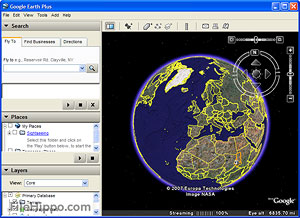Q7. How do other technologies and resources contribute?
Digital Resources

Google Earth Plus, a more sophisticated version of
the free Google Earth software which has
revolutionized how people see and access the
world.
I've already hit on a few of the digital websites and tools that can help foster a sense of place by delivering ecomedia content. Here are two other digital resources for our cause:
Google Earth
Of course you've heard of Google Earth; probably used it, too. What's doubly cool is the way planners and others are using it to reshape how we think about and strive to support place. For example, the Zoological Society of London is using Google Earth to highlight the world's most Evolutionarily Distinct and Globally Endangered (EDGE) species, and to bring the species' locations to life and create an interesting presentation that will engage users in the work to preserve them.
Google Maps
Related but technically distinct from Google Earth, Google Maps use the web browser rather than a distinct software interface. Since users can define locations and add data to maps to create community resources and topic-specific geographical information systems. For instance, check out this sweet little microbrewery finder. Not ecomedia oriented, you say? Don't say that to New Belgium Brewing Company, which receives its power from wind turbines and has an aggressive sustainability plan. You can find it on the Brewery Map by going to Fort Collins, Colorado.
Either Google is saving the world to take it over, or it's taking it over to save it. Either way, it offers dish after dish of searchable digital delight.
Next: Place-Based Resources![]()

